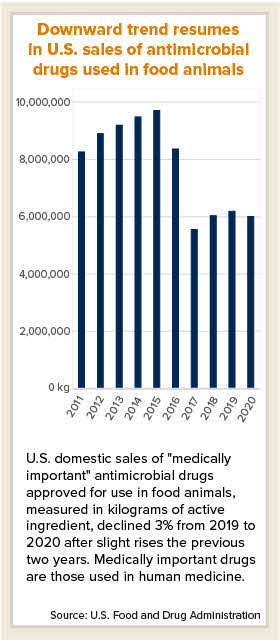 Quantities of antimicrobial drugs sold for use in food animals in the United States have fallen, ending a two-year run of increases and cooling concerns that a longer-term downward trend was abating.
Quantities of antimicrobial drugs sold for use in food animals in the United States have fallen, ending a two-year run of increases and cooling concerns that a longer-term downward trend was abating.
Regulators advocate careful use of drugs because overuse can contribute to antimicrobial resistance, or AMR, which occurs when pathogenic microbes evolve to withstand treatments meant to kill them.
Scientists consider AMR a major threat to humankind, should common infections now considered easily managed become untreatable.
Sales for use in production animals of "medically important" antimicrobials, which are drugs also used in human medicine, fell to 6,002,056 kilograms of active ingredient in 2020, a 3% drop from 2019 sales, the U.S. Food and Drug Administration reported this week.
The drop reversed a 3% rise recorded in the previous year and brought the decrease since 2015, which was the peak year of sales, to 38%. "This suggests that continued efforts to support the judicious use of antimicrobials in food-producing animals are having an impact," the FDA said.
Sales of all antimicrobial drugs for food-producing animals, including non-medically important treatments, fell by 9% in 2020 compared with 2019.
Demand across the board had fallen sharply in 2017 after the FDA banned the use of antimicrobials for promoting growth in livestock. The regulator also prohibited over-the-counter use in animal feed and water, while requiring oversight by veterinarians. A partial, temporary rebound in sales was expected post-2017 as people adjusted to the new requirements.
The resumption of a fall in sales in 2020, however, occurred amid the backdrop of the COVID-19 pandemic, which is having a complex influence on food supply and demand. During most countries' lockdowns, the supply of food was considered an essential service, and demand for groceries jumped as people spent more time cooking at home. Conversely, demand from the hospitality sector fell and supply-chain disruptions caused by workers isolating at home prompted some abattoirs to reduce operating capacity and cull throngs of livestock.
"The COVID-19 pandemic has undoubtedly had an impact on various aspects of animal agriculture, but it is difficult to know the extent, given that we're still in the midst of the pandemic," FDA spokesperson Anne Norris said.
"It may not be possible to ever accurately assess the influence of the pandemic on the sales of medically important antimicrobials retrospectively because there would be many potential confounding variables."
The FDA data does not include companion animals, though the regulator in August 2020 gave grants to two educational institutions — North Carolina State University and University of Minnesota — to explore and implement data-gathering methodologies for assessing antimicrobial use in companion animals. They are intended to be five-year projects, so their anticipated completion date is August 2025, Norris confirmed.
Most companion animal veterinarians are concerned about antimicrobial resistance, according to the results of a survey released last month conducted by the British Veterinary Association. It found that 92% of the 405 practitioners in the United Kingdom who responded were worried about their ability to treat infections in pets.
Sales also fall in the UK but rise in the EU
The use of antimicrobial drugs for animals also is falling elsewhere. Sales data collected for the U.K. and the European Union, for instance, show meaningful declines have been achieved over the past decade or so. Progress more recently has been lumpy.
In the U.K., sales of veterinary antibiotics, including for companion animals, fell 1% in 2020 compared with 2019 and were down 49% since 2014, according to a report published last month by the country's Veterinary Medicines Directorate (VMD). The slight fall in 2020 pared a 3% rise in the previous year. (Strictly defined, antibiotics are a subset of antimicrobial drugs, but the terms often are used interchangeably).
"Following on from last year, this year's report shows that the reductions in antibiotic use achieved in previous years have been held, with many sectors holding level or seeing modest reductions," VMD head of surveillance Kitty Healey said in the report's introduction.
"This in itself is an achievement given the gains already made, and while a continuing national downward trend for antibiotic consumption is still necessary, it is likely to be more gradual than in recent years."
In the EU, meanwhile, sales of veterinary antimicrobials from 25 member countries that provided data increased by a combined 6% in 2020 compared with 2019, according to a report released in November by the European Medicines Agency. The agency added, however, that "data for the next years are necessary to better understand this observation."
Even with that latest rise, sales among those EU countries still were down 43% in 2020 compared with 2011.